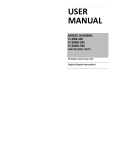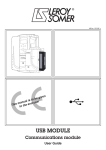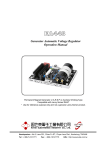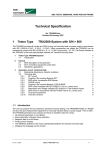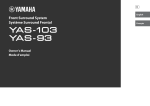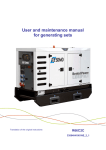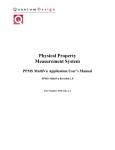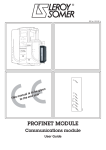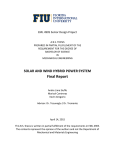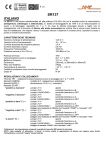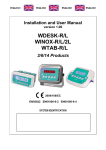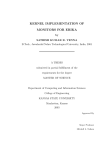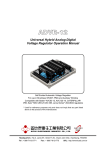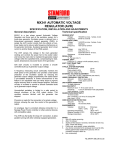Download R449 AVR Leroy Somer from Macfarlane Generators
Transcript
3983 en - 05.2008 / c s e nt e b us t m l a nu s er a u m d This o the en t (12V - 10A) J1 R 449 X2 Z1 X1 Z2 E+ E- + Isolated DC power supply t ~ 10 ohms Exciter field VOLTAGE REGULATOR R 449 revision f Installation and maintenance LEROY-SOMER INSTALLATION AND MAINTENANCE 3983 en - 05.2008 / c VOLTAGE REGULATOR R 449 revision f This manual concerns the alternator A.V.R. which you have just purchased. We wish to draw your attention to the contents of this maintenance manual. By following certain important points during installation, use and servicing of your A.V.R., you can look forward to many years of trouble-free operation. SAFETY MEASURES WARNING Before using your machine for the first time, it is important to read the whole of this installation and maintenance manual. All necessary operations and interventions on this machine must be performed by a qualified technician. Warning symbol for an operation capable of damaging or destroying the machine or surrounding equipment. Our technical support service will be pleased to provide any additional information you may require. The various operations described in this manual are accompanied by recommendations or symbols to alert the user to the potential risk of accidents. It is vital that you understand and take notice of the different warning symbols used. Warning symbol for general danger to personnel. This A.V.R. can be incorporated in a machine marked C.E. Warning symbol for electrical danger to personnel. Note: LEROY-SOMER reserves the right to modify the characteristics of its products at any time in order to incorporate the latest technological developments. The information contained in this document may therefore be changed without notice. 2 Copyright 2005: LEROY-SOMER This document is the property of: MOTEURS LEROY-SOMER It may not be reproduced in any form without prior authorization. All brands and models have been registered and patents applied for. LEROY-SOMER INSTALLATION AND MAINTENANCE 3983 en - 05.2008 / c VOLTAGE REGULATOR R 449 revision f TABLE OF CONTENTS 1 - Introduction to the R 449 ................................................................................................................... 4 1.1 - Application ................................................................................................................................ 4 1.2 - Description ............................................................................................................................... 4 1.2.1 - Power supply connection ............................................................................................. 4 1.3 - Electrical characteristics ........................................................................................................... 6 1.3.1 - Operating diagram ....................................................................................................... 6 1.3.2 - Detection ...................................................................................................................... 7 1.3.3 - Voltage accuracy ......................................................................................................... 7 1.3.4 - Voltage adjustment ...................................................................................................... 7 1.3.5 - Power supply ............................................................................................................... 7 1.3.6 - Output power ............................................................................................................... 7 1.3.7 - Quadrature droop (1F) ................................................................................................. 7 1.3.8 - Frequency compared with voltage (without LAM) ........................................................ 7 1.3.9 - LAM (Load Acceptance Module) characteristics ......................................................... 7 1.3.10 - Typical effects of the LAM with a diesel engine with or without a LAM (U/F only)...... 8 1.3.11 - Gradual voltage return function ................................................................................. 8 1.3.12 - Stability ...................................................................................................................... 8 1.3.13 - Limiting the excitation current Iex .............................................................................. 8 1.3.14 - Protection ................................................................................................................... 9 1.3.15 - Voltage build-up ......................................................................................................... 9 1.3.16 - Power used ................................................................................................................ 9 1.3.17 - De-energising ............................................................................................................ 9 1.4 - Environment ............................................................................................................................. 9 2 - R 726: Regulation of power factor (2F) and mains sensing (3F) ................................................. 10 2.1 - Operating diagram ................................................................................................................. 10 2.2 - Potentiometers ....................................................................................................................... 11 3 - Typical diagrams .............................................................................................................................. 12 3.1 - AREP 1F LV excitation .......................................................................................................... 12 3.2 - AREP 1F MV excitation ......................................................................................................... 13 3.3 - AREP 3F LV excitation .......................................................................................................... 14 3.4 - AREP 3F MV excitation ......................................................................................................... 15 3.5 - 1F LV shunt + booster excitation ........................................................................................... 16 3.6 - 1F LV PMG excitation ............................................................................................................ 17 4 - Commissioning ................................................................................................................................ 18 4.1 - In case of standalone regulation ............................................................................................ 18 4.2 - In case of 1F regulation (parallel operation between alternators) .......................................... 18 4.3 - In case of 2F (power factor regulation) and 3F (voltage match circuit) ................................. 18 5 - Troubleshooting ............................................................................................................................... 20 5.1 - Checking the windings and rotating diodes using a separate excitation ................................ 20 5.2 - Static checking of the regulator .............................................................................................. 20 5.3 - Troubleshooting table ............................................................................................................. 21 5.3.1 - In case of 1F, parallel operation between alternators ................................................ 21 5.3.2 - In case of 2F and 3F .................................................................................................. 23 5.3.3 - Checking the alternator using a separate excitation .................................................. 23 5.4 - Replacing the regulator with a spare voltage regulator .......................................................... 23 6 - Spare parts......................................................................................................................................... 24 6.1 - Designation ............................................................................................................................. 24 6.2 - Technical support service ....................................................................................................... 24 All such operations performed on the A.V.R. should be undertaken by personnel trained in the commissioning, servicing and maintenance of electrical and mechanical components. 3 INSTALLATION AND MAINTENANCE LEROY-SOMER 3983 en - 05.2008 / c VOLTAGE REGULATOR R 449 revision f INTRODUCTION TO THE R 449 1 - INTRODUCTION TO THE R 449 - A sensing selection jumper ST1 (single/3-phase with an external module) - A response time jumper ST2 - A frequency selection jumper ST3 - An external voltage setting jumper ST4 - A LAM (load adjustment module) jumper ST5 From R449 Version E number 10,000, this jumper will be removable. - A selection jumper 13% 25% LAM ST10 - Bend at 65 Hz (U/F) ST11 1.1 - Application The R 449 voltage regulator is of a shunt type. It is designed to fit as standard on A50 to A 54 alternators. It can be supplied with power either by a power VT, or by the AREP field excitation system, or by a single-phase or 3-phase PMG. Using the R 726 external module, the regulator can control the power factor (2F) and can match the alternator voltage to the mains voltage (3F) prior to synchronisation. Two fuses (F1 and F2) are connected to this regulator; they are mounted in the alternator on terminal block C. Type: gG 10/38 16A 500V. - ATQ20 (10x38US) 500 VAC UL/CSA 1.2 - Description Simplified diagram of a potentiometer: The electronic components mounted in a plastic casing are sealed with opaque elastomer. Connection is via 2 connectors (male "Faston" lugs 6.3) The regulator includes: - A main terminal strip (10 terminals) - A secondary terminal block (5 terminals) - A frequency selection terminal block (3 terminals) - A quadrature droop potentiometer - A voltage potentiometer - A stability potentiometer - A maximum excitation potentiometer To adjust the potentiometer, check the actual position of the potentiometer stop. Stop J1 J2 J3 P1 P2 P3 P5 0 5 10 1.2.1 - Power supply connection 1.2.1.1 - AREP system STATOR : 6 or 12-wire (marking T1 to T12) MAIN FIELD Aux. windings T1 T7 T2 T8 T3 T9 T4 T10 T5 T11 T6 T12 Varistor AREP SYSTEM 5+ Armature 6- Field 10 Yellow 11 Red 12 Black 9 Green according to tension X2 Z1 X1 Z2 E+ E- 0V 110 220 380 ST5 with LAM ST3 Frequency without LAM 4 x holes Ø 5.8 x 175 x 115 mm Quad droop P1 60Hz 50Hz R 449 ST10 LAM 200 mm 140 mm 13 % T.I. 25 % S2 Option S1 P5 ST11 ST2 P3 4 Excitation ceiling ST4 open knee-point: 65 Hz Response time Stability normal fast Option External potentiometer for adjusting the voltage ST1 Single-phase detection P2 Tension R731 Option 3-ph. detection INSTALLATION AND MAINTENANCE LEROY-SOMER 3983 en - 05.2008 / c VOLTAGE REGULATOR R 449 revision f INTRODUCTION TO THE R 449 1.2.1.2 - PMG system STATOR : 6 or 12-wire (marking T1 to T12) MAIN FIELD PMG SYSTEM Varistor Aux. windings 5+ T1 T7 T2 T8 T3 T9 T4 T10 T5 T11 T6 T12 PMG Armature 6- Field 14 15 16 according to tension 140 mm ST5 with LAM ST3 without LAM R 449 ST10 LAM Quad droop P1 60Hz 50Hz Frequency 4 x holes Ø 5.8 x 175 x 115 mm 200 mm X2 Z1 X1 Z2 E+ E- 0V 110 220 380 13 % T.I. 25 % S2 Option S1 Excitation ceiling P5 ST11 P3 External potentiometer for adjusting the voltage normal fast Response time ST2 Option ST4 open knee-point: 65 Hz ST1 Single-phase Stability P2 Tension R731 Option detection 3-ph. detection 1.2.1.3 - SHUNT system STATOR : 6 or 12-wire (marking T1 to T12) MAIN FIELD SHUNT SYSTEM T1 T7 T8 T3 T9 Varistor T2 5+ Armature 6- T4 T10 Field T11 T5 T6 T12 according to tension X2 Z1 X1 Z2 E+ E- 0V 110 220 380 ST5 with LAM ST3 Frequency without LAM 4 x trous Ø 5.8 x 175 x 115 mm Quad droop P1 60Hz 50Hz R 449 ST10 LAM 200 mm 140 mm 13 % T.I. 25 % S2 Option S1 P5 ST11 ST2 P3 Excitation ceiling ST4 open knee-point: 65 Hz Response time Stability normal fast Option External potentiometer for adjusting the voltage ST1 Single-phase detection P2 Tension R731 Option 3-ph. detection 5 6 1 3 Ph 2 ST4 3 S1 4 TI/CT S2 5 0V 4 110V 3 220V 2 BORNIER CONNECTOR J1 BORNIER CONNECTOR J2 BORNIER CONNECTOR J3 1 1 AC DC 1 POTENTIOMETRE TENSION EXTERIEUR POTENTIOMETER EXTERNAL VOLTAGE POTENTIOMETRE P1 STATISME VOLTAGE DROOP DETECTION 380V SENSING 1 TENSION VOLTAGE ST1 1 60Hz 2 50Hz 3 ST3 V/Hz SOUS-VITESSE UNDERFREQUENCY STABILITE STABILITY LAM ST5 % LAM ST10 65Hz ST11 P3 PID ST2 +15V P5 LIMITE D'EXCITATION EXCITATION LIMIT TEMPS TIME EXCITATEUR EXCITER RESISTANCE RESISTOR 5 6 TRANSISTOR DE PUISSANCE POWER TRANSISTOR X1 8 X2 10 Z1 9 Z2 7 LEROY-SOMER INSTALLATION AND MAINTENANCE 3983 en - 05.2008 / c VOLTAGE REGULATOR INTRODUCTION TO THE R 449 R 449 revision f 1.3 - Electrical characteristics 1.3.1 - Operating diagram INSTALLATION AND MAINTENANCE LEROY-SOMER 3983 en - 05.2008 / c VOLTAGE REGULATOR R 449 revision f INTRODUCTION TO THE R 449 1.3.2 - Detection 1.3.7 - Quadrature droop (1F) The detection is single-phase and is isolated using an internal transformer. Sensing VA: 5VA J1 connector, input voltages: Terminals 0-110V voltage range from 85 to 130V Terminals 0-220V voltage range from 170 to 260V Terminals 0-380V voltage range from 340 to 520V Quadrature droop is achieved using a parallel operation CT (In/1A, 10VA Cl1). The voltage droop can be adjusted using potentiometer P1. The voltage range is 5%Un for Pn PF 0.8. The quadrature droop is at 0 when potentiometer P1 has been rotated fully anti-clockwise. 1.3.3 - Voltage accuracy P1 The voltage accuracy is +/- 1%Un, steady state, linear load. 1.3.4 - Voltage adjustment The voltage is adjusted either using an internal potentiometer P2, with a voltage range of +/- 10%Un, or using an external potentiometer (as an option). The voltage is minimum when internal potentiometer P2 has been rotated fully anti-clockwise. 1.3.8 - Frequency compared with voltage (without LAM) Voltage Bend 100 % U/UN 50 Hz 50 Hz Connecting the external potentiometer: External potentiometer 470Ω 3W: Voltage range +/- 5%Un External potentiometer 1kΩ 3W: Voltage range +/- 10%Un (option). Remove jumper ST4 and connect the external potentiometer as shown in the diagram below. If a regulator is built into the terminal box, remove jumper ST10 from terminal block C and connect the external potentiometer. Internal J2 External Rhe ST4 60 Hz Frequency P2 J2 57.5 Hz 48 Hz ST4 Voltage setting : ST4 A.F. = Internal 1.3.5 - Power supply The power can be supplied: - using 2 independent auxiliary windings integrated in the alternator stator (AREP excitation) - using a single or 3-phase power VT - using a single or 3-phase PMG. The single or 3-phase voltage must not exceed 240V AC. 1.3.6 - Output power The output power is 7A 63V under normal conditions and 15A for 10s under overload conditions. Hz 60 Hz 1.3.9 - LAM (Load Acceptance Module) characteristics The LAM system is integrated in the regulator, as standard it is active (ST5 with bridge). It can be deactivated by removing the ST5 bridge. It can be adjusted to 13% or 25% by means of the ST10 jumper (factory setting 15%). - Role of the “LAM” (Load Acceptance Module): On application of a load, the rotation speed of the generator set decreases. When it passes below the preset frequency threshold, the LAM causes the voltage to drop by approximately 13% or 25% and consequently the amount of active load applied is reduced by approximately 25% to 45%, until the speed reaches its rated value again. Hence the LAM can be used either to reduce the speed variation (frequency) and its duration for a given applied load, or to increase the applied load possible for one speed variation (turbo-charged engine). To avoid voltage oscillations, the trip threshold for the LAM function should be set approximately 2 Hz below the lowest frequency in steady state. It is advisable to use the LAM at 25% for load impacts Š 70% of the genset rated power. Voltage Underspeed and LAM ST5 disconnected UN P2 U/f LAM 0.87 UN 0 Voltage 48 or 57.5 Hz ST3 fC 50 or 60 Hz fN 7 INSTALLATION AND MAINTENANCE LEROY-SOMER 3983 en - 05.2008 / c VOLTAGE REGULATOR R 449 revision f INTRODUCTION TO THE R 449 1.3.10 - Typical effects of the LAM with a diesel engine with or without a LAM (U/F only). 1.3.10.1 - Voltage 1.3.12 - Stability The stability and the response time of the alternator can be adjusted using potentiometer P3. Presetting P3 for different types of alternator: Transient voltage drop UN 0 5 A50 10 0,9 (U/f) without LAM with LAM 0,8 1s 0 A54 Time 2s 3s 1.3.10.2 - Frequency Max speed drop with LAM fN 0.9 without LAM 0.8 1s 0 2s Time 3s 1.3.10.3 - Power Load on the shaft (kW) LAM Variation in the load Load shedding due to "LAM" 1s 0 2s Time 3s 1.3.11 - Gradual voltage return function During load impacts, the function helps the genset to return to its rated speed faster thanks to a gradual increase in voltage according to the principle: - If the speed drops between 46 and 50 Hz, the rated voltage follows a fast gradient as it is restored. - If the speed drops below 46 Hz, since the engine needs more help, the voltage follows a slow gradient as it returns to the reference value. A51/52 A53 The ST2 jumper modifies the stability. It is closed as standard. Removing this jumper can in some cases improve the response time of the alternator (contact Leroy-Somer). 1.3.13 - Limiting the excitation current iex - The potentiometer P5 is used to adjust the limitation of excitation Amp. Limitation of the excitation current is active for 10s. After this period of time, the excitation current is limited to 2A. The maximum limitation is 15A. The minimum limitation is when the potentiometer has been rotated fully anti-clockwise. In the absence of specification to the contrary, P5 is positioned at the clockwise limit. - Static adjustment of the maximum excitation current For this value, the static adjustment is possible when the alternator is stopped, which will not endanger the alternator or the installation. Disconnect the power supply wires X1,X2 and Z1,Z2 and the alternator voltage reference (terminal strip J1). Connect the power supply, 200 to 240V, as shown (X1 and X2: 0-220V). Install a 20 ADC ammeter in series with the exciter field. Turn P5 fully anti-clockwise, switch on the power supply (circuit breaker A). If the regulator does not discharge, turn potentiometer P2 (voltage) clockwise until the ammeter indicates a stabilised current. Switch the power supply off and then on again, turn P5 clockwise until the required excitation current is reached (limited to 15A), (for precise adjustment contact Leroy-Somer). Checking the internal protection: Open the circuit breaker (D): the excitation current must rise to its preset upper limit, maintain this value for 10s and fall back automatically to a value less than 1A. To reset, switch off the power supply using the circuit breaker (A). Note: After setting the upper excitation limit using this procedure, re-adjust the voltage. According to frequency U ST3 Drop N ≤ 46 Hz Drop N > 46 Hz Time Mains (Supply 50/60 Hz) R 449 P5 X2 Z1 X1 Z2 E+ E0V 50Hz 60Hz ST5 Excit max ST2 0 P3 P2 ST1 Exciter field ~ 10 ohms S1 S2 ST4 220V 380V + - A P1 Voltage 8 A D 20A DC INSTALLATION AND MAINTENANCE LEROY-SOMER 3983 en - 05.2008 / c VOLTAGE REGULATOR R 449 revision f INTRODUCTION TO THE R 449 1.3.14 - Protection 1.4 - Environment There are two fuses in the power section. They are mounted externally to the AVR but inside the alternator terminal box. Rating: gG 10/38 16A 500V - ATQ20 (10x38US) 500 VAC UL/CSA - Operating temperature: - 30°C to +70°C - Storage temperature: - 55°C to + 85°C - Shocks on the base: 9g for the 3 right-angled directions - Vibrations: Less than 10Hz: 2mm half peak amplitude 10Hz to 100Hz: 100mm/s Above 100Hz: 8g 1.3.15 - Voltage build-up The voltage build-up is automatic (no overvoltage) from the residual magnetism. If there is no voltage build-up, a short pulse of continuous isolated voltage (12VDC), will usually remedy this. Otherwise, proceed in accordance with the diagram below to re-establish the residual magnetism: (12V - 10A) J1 R 449 X2 Z1 X1 Z2 E+ E- + Isolated DC power supply t ~ 10 ohms Exciter field 1.3.16 - Power used The power used by the R 449 is 30W, when the alternator is at rated power. 1.3.17 - De-energising The regulator is de-energised by switching off the voltage regulation power supply. Contact rating: 15A, 250V AC J1 R 449 Aux. windings X2 Z1 X1 Z2 E+ E- 9 INSTALLATION AND MAINTENANCE LEROY-SOMER 3983 en - 05.2008 / c VOLTAGE REGULATOR R 449 revision f R 726: REGULATION OF POWER FACTOR (2F) AND MAINS SENSING (3F) 2 - R 726: REGULATION OF POWER FACTOR (2F) AND MAINS SENSING (3F) The power factor and mains sensing are done by the R726 module. See the specific manual. 10 FUNCTIONAL DIAGRAM SYNOPTIQUE DE FONCTIONNEMENT 2.1 - Operating diagram INSTALLATION AND MAINTENANCE LEROY-SOMER 3983 en - 05.2008 / c VOLTAGE REGULATOR R 449 revision f R 726: REGULATION OF POWER FACTOR (2F) AND MAINS SENSING (3F) 2.2 - Potentiometers P1: Potentiometer for adjusting the alternator voltage to the mains voltage (operating mode 3F). P2: Adjustment of the power factor P3: Stability P4: Limitation of the power factor 115 mm 100 mm U=U J2 } } T3 LED 10 9 8 7 6 5 4 3 2 1 RED "U = U" T2 GREEN "Cos ϕ" STAB P3 P1 LIMIT P4 T1 Cos ϕ P2 ST1 ST2 CONTROL OUTPUT R2 R1 J1 P5 C1 C2 } MAINS VOLTAGE (PHASES 2-3) 400 GENERATOR VOLTAGE 100 (PHASES 2-3) 0 } S2 S1 } TI / CT / 1A (PHASE 1) POTENTIOMETERS 1 2 3 4 5 6 7 8 9 10 To A.V.R. 400 100 0 SENSING 50/60 Hz R 726 P6 P1 MORE GEN VOLTAGE P2 MORE REACTIVE POWER P3 STABILITY (// with mains) P4 P.F. LAG Limit U VOLTAGE Unused terminal U=U "Cos ϕ""Cos ϕ" ADJUSTMENTS / MONITORING P5 : (-R) = MORE VOLTAGE (single) + P6 : (+R) = MORE REACTIVE POWER + 11 INSTALLATION AND MAINTENANCE LEROY-SOMER 3983 en - 05.2008 / c VOLTAGE REGULATOR R 449 revision f TYPICAL DIAGRAMS 3 - TYPICAL DIAGRAMS The following diagrams are supplied for information only and are not to be used in place of the actual alternator diagrams. 3.1 - AREP 1F LV excitation 12 LEROY-SOMER INSTALLATION AND MAINTENANCE 3983 en - 05.2008 / c VOLTAGE REGULATOR R 449 revision f TYPICAL DIAGRAMS 3.2 - AREP 1F MV excitation 13 LEROY-SOMER INSTALLATION AND MAINTENANCE VOLTAGE REGULATOR R 449 revision f TYPICAL DIAGRAMS 3.3 - AREP 3F LV excitation 14 3983 en - 05.2008 / c LEROY-SOMER INSTALLATION AND MAINTENANCE 3983 en - 05.2008 / c VOLTAGE REGULATOR R 449 revision f TYPICAL DIAGRAMS 3.4 - AREP 3F MV excitation 15 LEROY-SOMER INSTALLATION AND MAINTENANCE VOLTAGE REGULATOR R 449 revision f TYPICAL DIAGRAMS 3.5 - 1F LV Shunt + Booster excitation 16 3983 en - 05.2008 / c INSTALLATION AND MAINTENANCE LEROY-SOMER 3983 en - 05.2008 / c VOLTAGE REGULATOR R 449 revision f TYPICAL DIAGRAMS 3.6 - 1F LV PMG excitation 17 LEROY-SOMER INSTALLATION AND MAINTENANCE 3983 en - 05.2008 / c VOLTAGE REGULATOR R 449 revision f COMMISSIONING 4 - COMMISSIONING The commissioning principle is the same whatever is the type of excitation. 4.1 - In case of standalone regulation - Check fuses F1 and F2 which are situated on terminal block C in the alternator. - Check the regulator: - Check the position of the ST3 jumper (select the frequency, 50 or 60Hz). - If an external voltage potentiometer is used, disconnect it from the regulator and install the ST4 jumper (regulator terminal block J2) or the ST10 jumper, terminal block C in the alternator terminal box. - Turn the internal voltage potentiometer P2 on the regulator fully anti-clockwise. voltage, if the voltage rises, invert the parallel operation CT. The voltage quadrature droop is generally 2 to 3% of the rated voltage. - The no-load voltages should be identical on all the alternators intended for parallel operation between each other. - Connect the alternators in parallel at no load. - Adjust the setting of voltage P2 or the external voltage potentiometer of one of the machines, try to eliminate (or minimise) the circulating stator current between the machines. - Do not adjust the voltage further. - Match the kW power with a minimum load of 30% by adjusting the drive system speed. - Adjust quadrature droop potentiometer P1 on one of the machines to balance or distribute the stator currents. - If several alternators are in parallel, take one as a reference. - Set the alternator to its rated speed using the drive system. - The alternator voltage should rise to a value of 85 to 90%Un. - Adjust the voltage to the required value using potentiometer P2. 4.3 - In case of 2f (power factor regulation) and 3f (voltage match circuit) (see R726 manual ref. 2440) - Turn potentiometer P1 fully anti-clockwise. - Check the wiring between the R 449 and the R 726. (See the connection diagram). - Perform an on-load test with power factor = 0.8 or power factor = 1. The voltage should remain constant within the limits of the regulator. If it is not stable, see section 13-9. - Check the information given for the R 726: mains voltage, 2F contact, 3F contact. - Stop the alternator and reconnect the potentiometer, setting it to the centre position. external - Set the alternator to its rated speed then, using the external potentiometer, set the alternator to its rated voltage. - The regulator set-up phase is now complete. 4.2 - In case of 1f regulation (parallel operation between alternators) - The previous settings should be made on each alternator. - Set the quadrature droop potentiometer to the centre position and perform an on-load test. - With a load at power factor = 1, the voltage does not drop or only drops slightly; with an inductive load, the voltage drops. This voltage drop is set using quadrature droop potentiometer P1. The no-load voltage is always greater than the on-load 18 - If an external voltage potentiometer is used, disconnect it from the R 726 and add the ST1 jumper (terminals 3 and 4 of J1) or disconnect it from terminals 25 and 26 of terminal block C of the alternator and add the ST10 jumper. - If an external PF potentiometer is used, disconnect it from the R 726 and add the ST2 jumper (terminals 9 and 10 of J1) or disconnect it from terminals 29 and 30 of terminal block C of the alternator and add the ST11 jumper. - Perform a 1F test. The test principle is the same as in the case of 1F regulation. - Matching the alternator and mains voltages prior to synchronisation (3F): - If this function is not used, match the voltages by adjusting the voltage potentiometer. The following settings are for the R 726. Close the 3F contact (terminals 5 and 6 of J1 of the R 726 or terminals 34 and 35 of terminal block C of the alternator). The red LED lights up. Adjust potentiometer P1 to match the alternator voltage to the mains voltage. - Power factor regulation with the alternator synchronised with the mains (2F): INSTALLATION AND MAINTENANCE LEROY-SOMER 3983 en - 05.2008 / c VOLTAGE REGULATOR R 449 revision f COMMISSIONING The following settings are for the R 726. When the alternator is in phase with the mains and the mains and alternator voltages are equal, proceed with synchronisation. Contact 2F closes when the circuit breaker is closed. The green LED on the R 726 lights up. Open contact 3F and remove the mains voltage reference. Preset the PF potentiometer P2 to 5 and limit potentiometer P4 to 3.5. Without supplying kW power to the mains, the reactive current of the alternator should be at or around 0. Increase the kW power. When it reaches 50% of the rated power, adjust potentiometer P4 to obtain a PF of 0.9 LAG (inductive) on the alternator. The range is then 0.7 LAG PF (inductive) (P2 turned fully clockwise) to 0.95 LEADING (capacitive) (P2 turned fully anti-clockwise). Adjust P2 to obtain the required power factor value. Increase the kW power until it reaches the rated power. The PF should remain constant. If it becomes unstable, adjust potentiometer P3 on the R 726 or potentiometer P3 on the R 449. - Stop the alternator potentiometers. and reconnect the external 19 INSTALLATION AND MAINTENANCE LEROY-SOMER 3983 en - 05.2008 / c VOLTAGE REGULATOR R 449 revision f TROUBLESHOOTING 5 - TROUBLESHOOTING 5.1 - Checking the windings and rotating diodes using a separate excitation During this procedure, you must check that the alternator is not connected to any external loads and examine the terminal box to check that the connections have been made correctly. Do not perform dielectric tests without disconnecting the module and associated AVR. RISK OF DESTRUCTION - Stop the generator, disconnect and isolate the regulator wires. ASSEMBLY B Variac - There are two possible assemblies for a separate excitation: see the diagrams below. 50 90 10 80 20 70 - Assembly A: Connect the DC supply (2 batteries in series) in series with a rheostat of approximately 20 ohms/500W and a diode on both field winding wires (5+) (6-) 100 0 Diode 5 A - - AC 220 V ASSEMBLY A 6 - Exciter field 5+ Rh. 20 - 500 W + Battery 12V - Assembly B: Connect a "variac" variable power supply and a diode bridge to both field winding wires (5+) (6-). 5+ + 60 30 40 6 - Exciter field Diode 5A 5.2 - Static checking of the regulator If the regulator operates correctly during a static test, this does not necessarily mean that it will operate correctly under real conditions. If the regulator fails the static test, it can be concluded without doubt that the regulator is faulty. Connect a test bulb in accordance with the diagram. The power supply voltage must be between 200 and 240V. The voltage of the bulb is 230V. The power of the bulb will be less than 100W. - Turn potentiometer P2 fully anti-clockwise. - These two systems must be compatible with the excitation rating of the machine (see the nameplate). - Switch the regulator on; the bulb must briefly light up and then go out. - Run the generator set at its nominal speed. - Slowly turn the voltage potentiometer clockwise, to the right. - Gradually increase the power supply current of the field winding by adjusting the rheostat or variac and measure output voltages L1, L2, L3, checking the no-load excitation voltages and currents. (See the alternator nameplate or ask Leroy-Somer for the test log). - When turned fully clockwise, the bulb lights up continuously. - If the output voltages are at their rated values and are balanced at < 1% for the given excitation value, the machine is operating correctly and the fault is due to the regulation part (regulator, wiring, sensing, auxiliary windings). - At the regulation point, turning the voltage adjustment potentiometer slightly in one direction or the other should make the bulb light up or go out. If the bulb is either lit continuously or does not light up at all, the regulator is faulty. - Perform one test supplying the regulator via terminals X1 and X2, then another supplying it via terminals Z1 and Z2. According to frequency ST3 200 - 240 V (220 V) R 449 P5 X2 Z1 X1 Z2 E+ E0V 50Hz 60Hz ST5 ST2 P3 When the alternator is stopped, mains voltage may still be present at the module voltage sensing terminals. 20 P2 ST1 Mains (Supply 50/60 Hz) P1 S1 S2 Voltage ST4 220V 380V V 300 V : DC INSTALLATION AND MAINTENANCE LEROY-SOMER 3983 en - 05.2008 / c VOLTAGE REGULATOR R 449 revision f TROUBLESHOOTING 5.3 - Troubleshooting table - Before taking any action on the R 449 or the R 726, pay careful attention to the positions of the potentiometers and the jumpers. 5.3.1 - In case of 1F, parallel operation between alternators Symptom Absence of voltage on start-up, at no load. Voltage too high and adjustment potentiometer not operating. Voltage too high, but adjustable by the adjustment potentiometer. Voltage too low, but adjustable by the adjustment potentiometer. Probable causes Solutions - No residual magnetism or polarity inversion between the excitation output and the exciter input. - Voltage built-up is required. - De-energising contacts open. - Close this contact. - The speed is less than the rated speed. - Adjust the speed. - Connection lost between the regulator and the exciter. - Check the wiring. - Alternator loaded or short-circuited. - Remove the load from the alternator. - External potentiometer connected incorrectly - Check the wiring. - Faulty regulator - Test it or change it. - Faulty exciter or rotating diode bridge - Check the exciter and the diodes. - Fuses blown. - Replace the fuses. - Incorrect voltage at the sensing terminals. - Check the wiring of the 0, 110V, 220V, 380V terminals on terminal block J1. - Loss of sensing. - Check the wiring. - The external potentiometer has an incorrect value. - Set a potentiometer with the correct value. - Faulty regulator. - Test it or change it. - Voltage potentiometer set too high. - Adjust voltage potentiometer P2 or the external potentiometer. - Regulator sensing incorrect. - Check the wiring and the sensing value, at 0V and 110V, 220V, 380V terminals. - Regulator faulty. - Test it or change it. - ST3 and ST4 jumpers. - Check the presence of the ST3 and ST4 jumpers. - The speed is too low. - Set to the correct speed. - Exciter and rotating diodes. - Check the exciter and the rotating diodes. 21 LEROY-SOMER INSTALLATION AND MAINTENANCE 3983 en - 05.2008 / c VOLTAGE REGULATOR R 449 revision f TROUBLESHOOTING Symptom Incorrect regulation. Voltage unstable. Response time too long. Considerable drop in voltage, on-load. Probable causes Solutions - Distortion of the waveform, non-linear load. - Contact Leroy-Somer. - Unbalanced load. - Balance the load or change the sensing points. - The speed is not at the correct value. - Adjust the speed. - Exciter or rotating diodes faulty. - Check the exciter and the rotating diodes. - Faulty regulator. - Test it or change it. - Frequency unstable. - Check the stability of the drive system speed. - Secondary sensing of a transformer supplying other devices. - Provide separate sensing for the alternator. - Stability potentiometer P3 is incorrectly set. - Adjust stability potentiometer P3. - Faulty regulator. - Test it or change it. - Stability adjustment. - Adjust stability potentiometer P3 and the ST2 jumper. - Speed regulator response too long. - Adjust the stability of the speed. - Vectorial composition fault between the voltage - Check the wiring of the sensing and parallel and the current. operation CT. - The parallel operation CT ratio is incorrect. kVAR not stable between - Quadrature droop potentiometer needs alternators (reactive current adjusting. circulation). - The no-load voltages are not identical. - Correct the CT ratio. - Adjust the quadrature droop potentiometer. - Check that all the alternators have the same no-load voltage value. - Phases not connected to the sensing correctly. - Check the sensing wiring. - The CT is not on the correct phase. - Check the position of the parallel operation CT. Warning : after operational testing, replace all access panels or covers. 22 INSTALLATION AND MAINTENANCE LEROY-SOMER 3983 en - 05.2008 / c VOLTAGE REGULATOR R 449 revision f TROUBLESHOOTING 5.3.2 - Example of 2F and 3F Symptom Incorrect regulation of PF, PF potentiometer not operating. Probable causes Solutions - Vectorial composition fault between the sensing - Check the sensing wiring and the parallel operation CT. voltage and the stator current. - Change the module. - R 726 faulty. - R 726 ST2 jumper missing. Check the wiring, in particular the wires - Wiring fault between the R 449 and the R 726. -between 1 and 2 of terminal block J1 on the R 726. PF range incorrect. - Settings on potentiometers P2 incorrect. - Reset the range as shown above. The LEDs will not light up. - Contacts 2F and 3F missing. - Check the wiring. Cannot adjust the voltage matching circuit. - The sensing voltage is incorrect or incorrectly connected. - Check the wiring and the value of the voltage. 5.4 - Replacing the regulator with a spare voltage regulator Warning : after operational testing, replace all access panels or covers. - Set the potentiometers and the jumpers in the same way as the original regulator. 5.3.3 - Checking the alternator using a separate excitation - The alternator is tested at no load. - Disconnect the R 449 and R 726 and the entire excitation system of the alternator. - Connect a 24V 5A variable DC supply to the exciter field wires. Apply a direct current to the exciter to obtain the rated voltage. - Check all the alternator parameters: Stator voltage, field winding voltage, AREP or regulator power transformer voltages, sensing voltage at the regulator terminal block. - All these parameters should be checked against the alternator characteristics. 23 LEROY-SOMER INSTALLATION AND MAINTENANCE VOLTAGE REGULATOR R 449 revision f SPARE PARTS 6 - SPARE PARTS 6.1 - Designation Description A.V.R. Type R 449 Code AEM 220 RE 030 6.2 - Technical support service Our technical support service will be happy to provide any information you require. When ordering spare parts, you should indicate the complete machine type, its serial number and the information indicated on the nameplate. Part numbers should be identified from the exploded views and their description in the parts list. Our extensive network of "service stations" can dispatch the necessary parts without delay. To ensure correct operation and the safety of our machines, we recommend the use of original manufacture spare parts. In the event of failure to comply with this advice, the manufacturer cannot be held responsible for any damage. 24 3983 en - 05.2008 / c LEROY-SOMER INSTALLATION AND MAINTENANCE 3983 en - 05.2008 / c VOLTAGE REGULATOR R 449 revision f NOTES 25 LEROY-SOMER INSTALLATION AND MAINTENANCE VOLTAGE REGULATOR R 449 revision f NOTES 26 3983 en - 05.2008 / c LEROY-SOMER INSTALLATION AND MAINTENANCE 3983 en - 05.2008 / c VOLTAGE REGULATOR R 449 revision f NOTES 27 MOTEURS LEROY-SOMER 16015 ANGOULÊME CEDEX - FRANCE 338 567 258 RCS ANGOULÊME S.A. au capital de 62 779 000 ¤ www.leroy-somer.com




























